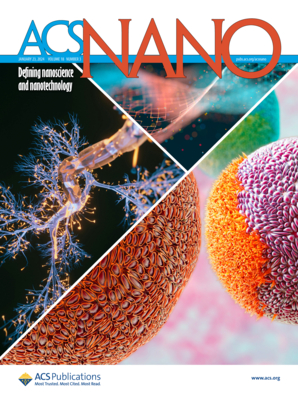Pd@Au Nanoframe Hydrogels for Closed-Loop Wound Therapy
IF 15.8
1区 材料科学
Q1 CHEMISTRY, MULTIDISCIPLINARY
引用次数: 0
Abstract
In this work, a multifunctional Pd@Au nanoframe hydrogel was designed to detect uric acid (UA) for in situ monitoring of wound infection and enhance wound healing by a chemo-photothermal strategy. In acidic conditions, the Pd@Au nanoframe hydrogels show high peroxidase-like activity by catalyzing H2O2 to produce reactive oxygen species (ROS) to damage RNAs of bacteria and enhance antibacterial activity. Under Near-infrared (NIR) laser irradiation, the Pd@Au nanoframe hydrogels exhibit photothermal conversion performance; i.e., the color of Pd@Au nanoframe hydrogel solution varies from deep blue (0 s, 25.4 °C) to red (300 s, 50.1 °C) in infrared thermography. After loading the antibacterial mupirocin (M), the as-obtained M Pd@Au nanoframe hydrogels show a maximum cumulative release rate exceeding 90% for mupirocin, as controlled by NIR laser irradiation. In antimicrobial experiments in vitro, M Pd@Au nanoframe hydrogels exhibit NIR laser-driven antibacterial ability; i.e., 98% Escherichia coli are effectively killed in 10 min. After coating rabbit wounds with a UA sensing patch of M Pd@Au nanoframe hydrogels, wound status can be monitored in real time by detecting UA concentration, leading to rapid wound healing in 4 days by a new synergistic effect of chemo-photothermal strategy. This approach successfully confirms a closed-loop strategy, i.e., real-time monitoring the status of a wound and efficiently perform chemo-photothermal wound therapy, for wound healing by combining functional hydrogels, NIR laser irradiation, and pharmaceutical antibacterials.

求助全文
约1分钟内获得全文
求助全文
来源期刊

ACS Nano
工程技术-材料科学:综合
CiteScore
26.00
自引率
4.10%
发文量
1627
审稿时长
1.7 months
期刊介绍:
ACS Nano, published monthly, serves as an international forum for comprehensive articles on nanoscience and nanotechnology research at the intersections of chemistry, biology, materials science, physics, and engineering. The journal fosters communication among scientists in these communities, facilitating collaboration, new research opportunities, and advancements through discoveries. ACS Nano covers synthesis, assembly, characterization, theory, and simulation of nanostructures, nanobiotechnology, nanofabrication, methods and tools for nanoscience and nanotechnology, and self- and directed-assembly. Alongside original research articles, it offers thorough reviews, perspectives on cutting-edge research, and discussions envisioning the future of nanoscience and nanotechnology.
 求助内容:
求助内容: 应助结果提醒方式:
应助结果提醒方式:


